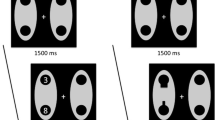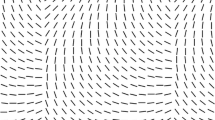Abstract
To examine whether the top–bottom axis has an inherent advantage in object perception over the left–right one, three experiments were conducted. In all of them, on each trial one of two alternative stimuli, identical in shape but opposite in direction (viz, related by reflection), was presented. Both reflection about the vertical axis and reflection about the horizontal axis were applied, in different blocks. In Experiment 1, objects with an orientation-free definition (arrows, incomplete squares) were presented. Subjects were to respond when the stimulus pointed in a specific direction, and to refrain from responding when it was reflected, namely pointed in the opposite direction. Axis of reflection (vertical, horizontal) was varied between blocks. In Experiment 2, the object was a Hebrew character asymmetric on both axes, presented either in its normal appearance or reflected. Subjects were to respond only when the stimulus was normal. Both axis of reflection (vertical, horizontal) and orientation angle (upright, tilted by 90°) were varied between blocks. In Experiment 3, stimuli were the same as in Experiment 2, but the task explicitly asked for a binary reflection judgment (normal vs. reflected). No sign for the presence of an axis effect was observed in any of those experiments, which seems incompatible with the hypothesis of vertical advantage in object perception. It is suggested that most vertical advantage observed before is due to extra-perceptual processing.



Similar content being viewed by others
Notes
Symmetry about the sagittal axis (namely, front vs. back) is also quite rare. However, since visual information about that axis is very often sparse in most natural settings, it must have quite a modest weight in perception. Anyhow, this study focuses just on the difference between the principal axes of the frontal (coronal) plane, namely the horizontal and the vertical axes.
In an auxiliary experiment with another Hebrew character (Beth), conducted to gain some more generality, no evidence in favor of PVAH was observed either.
And even those are, in many people, not sufficient for realizing how one’s own mirror image is related with her real frontal image (Takano & Tanaka, 2007).
But Hollingworth (2005) reports degrees of accuracy in localizing objects in natural scenes that are about the same in the two frontal axes. See also Carr & Roskos-Ewoldsen (1999) for evidence that naming locations encoded from narratives was more accurate in the horizontal plane than in both vertical planes—sagittal and coronal.
References
Appelle, S. (1972). Perception and discrimination as a function of stimulus orientation—oblique effect in man and animals. Psychological Bulletin, 78, 266–278.
Benton, A. L. (1959). Right left discrimination and nfinger localization: Development and pathology. New York: Hoeber-Harper.
Benton, A. L. (1992). Gerstmann’s syndrome. Archives of Neurology, 49, 445–447.
Boone, D. R., & Prescott, T. E. (1968). Development of left–right discrimination in normal children. Perceptual and Motor Skills, 26, 267–274.
Buchanan-Smith, H. M., & Heeley, D. W. (1993). Anisotropic axes in orientation perception are not retinotopically mapped. Perception, 22, 1389–1402.
Butler, J. (1964). Visual discrimination of shape by humans. Quarterly Journal of Experimental Psychology, 16, 272–276.
Carr, W., & Roskos-Ewoldsen, B. (1999). Spatial orientation by mental transformation. Psychological Research, 62, 36–47.
Cooper, L. A., & Shepard, R. N. (1973). Chronometric studies of the rotation of mental images. In W. G. Chase (Ed.), Visual information processing (pp. 75–176). New York: Academic Press.
Corballis, M. C. (1988). Recognition of disoriented shapes. Psychological Review, 95, 115–123.
Corballis, M. C. (2000). Much ado about mirrors. Psychonomic Bulletin & Review, 7, 163–169.
Corballis, M. C. (2001). Why mirrors reverse left and right: Commentary on Navon on mirror reversal. Psycholoquy, 12 (032).
Corballis, M. C., & Beale, I. L. (1976). The psychology of left and right. Hillsdale, NJ: Erlbaum.
Davidson, H. P. (1935). A study of the confusing letters b, d, p, q. Journal of Genetic Psychology, 47, 458–468.
Fisher, C. B., & Fracasso, M. P. (1987). The Goldmeier effect in adults and children: Environmental, retinal, and phenomenal influences on judgments of visual symmetry. Perception, 16, 29–39.
Goldmeier, E. (1972). Similarity in visually perceived forms. Psychological Issues, 8, Monograph 29, 1–135. Originally published: (1937) Uber Ahnslichkeit bei gesehenen figuren. Psychologische Forschung, 21, 146–208).
Gregory, R. L. (1987). Mirror reversal. In R. L. Gregory (Ed.), The Oxford companion to the mind (pp. 491–493). Oxford: Oxford University Press.
Gregory, R. (1997). Mirrors in mind. Oxford: Freeman.
Harley, T. A. (2001). The psychology of language: From data to theory (2nd ed. ed.). Hove: Psychology Press.
Hollingworth, A. (2005). Memory for object position in natural scenes. Visual Cognition, 12, 1003–1016.
Hunt, E., & Agnoli, F. (1991). The Whorfian hypothesis: A cognitive psychological perspective. Psychological Review, 98, 377–389.
Jolicoeur, P. (1985). The time to name disoriented natural objects. Memory and Cognition, 13, 289–303.
Jolicoeur, P., & Kosslyn, S. M. (1983). Coordinate systems in the long-term memory representation of three-dimensional shapes. Cognitive Psychology, 15, 301–345.
Konorski, J. (1964). On the mechanism of instrumental conditioning. In Proceedings of the 17th international congress of psychology. Amsterdam: North-Holland.
Kosslyn, S. M., & Rabin, C. (1999). The representation of left–right orientation: A dissociation between imagery and perceptual recognition. Visual Cognition, 6, 497–508.
Landau, B. (2003). Axes and direction in spatial language and spatial cognition. In E. van der Zee & J. Slack (Eds.), Representing direction in language and space (pp. 18–38). Oxford: Oxford University Press.
Levelt, W. J. M. (1984). Some perceptual limitations on talking about space. In A. J. van Doorn, W. A. van de Grind & J. J. Koenderink (Eds.), Limits in perception (pp. 323–358). Utrecht: VNU Science.
Louis, M., Huber, T., Benton, R., Sakmar, T. P, & Vosshall, L. B. (2007). Bilateral olfactory sensory input enhances chemotaxis behavior. Nature Neuroscience . doi:10.1038/nn2031.
Mach, E. (1959). The analysis of sensations, and the relation of the physical to the psychical. New York: Dover Publications. First published in English: (1897) Chicago, IL: Open Court; originally published in German: (1886) Beiträge zur Analyse der Empfindungen. Jena: Fischer.
Muller, R. U. (1996). A quarter of century of place cells. Neuron, 17, 813–822.
Navon, D. (1987). Why do we blame the mirror for reversing left and right? Cognition, 27, 275–283.
Navon, D. (2001). The puzzle of mirror reversal: A view from Clockland. Psycholoquy, 12 (017).
Navon, D. (2002). It’s not all in our mind: A reply to Corballis. Psycholoquy, 13 (012).
Onley, J. W., & Volkmann, J. (1958). The visual perception of perpendicularity. American Journal of Psychology, 71, 504–516.
Park, D. C., & James, C. Q. (1983). Effect of encoding instructions on children’s spatial and color memory: Is there evidence for automaticity? Child Development, 54, 61–68.
Pears, D. (1952). The incongruity of counterparts. Mind, 61, 78–81.
Piaget, J. (1959). Judgement and reasoning in the child. Paterson, N.J.: Littlefield, Adams. First published in English: (1928) London: Routledge & Kegan Paul.
Poucet, B. (2007). Animal navigation and cognitive maps. In L. Nadel (Ed.), Encyclopedia of cognitive science (Vol. 1, pp. 150–156). London: Wiley.
Quinn, P. C. (2004). Visual perception of orientation is categorical near vertical and continuous near horizontal. Perception, 33, 897–906.
Roberts, R. J., & Aman, C. J. (1993). Developmental differences in giving directions: Spatial frames of reference and giving directions. Child Development, 64, 1258–1270.
Roberson, D., Davies, I., & Davidoff, J. (2000). Color catergories are not universal: Replications and new evidence from stone-age culture. Journal of Experimental Psychology: General, 129, 369–398.
Rock, I. (1973). Orientation and form. New York: Academic Press.
Rudel, R. G., & Teuber, H. L. (1963). Discrimination of direction line in children. Journal of Comparative and Physiological Psychology, 56, 892–898.
Serpell, R. (1971). Discrimination of orientation by Zambian children. Journal of Comparative and Physiological Psychology, 75, 312–316.
Shimron, J., & Navon, D. (1981). The distribution of information within letters. Perception and Psychophysics, 30, 483–491.
Slack, J., & Van der Zee, E. (2003). The representation of direction in language and space. In E. van der Zee & J. Slack (Eds.), Representing direction in language and space (pp. 1–17). Oxford: Oxford University Press.
Standing, L., Conezio, J., & Haber, R. N. (1970). Perception and memory for pictures: Single-trial learning of 2500 visual stimuli. Psychonomic Science, 19, 73–74.
Tabata, T., & Okuda, S. (2000). Miror reversal simply explained without recourse to psychological processes. Psychonomic Bulletin & Review, 7, 170–173.
Takano, Y. (1998). Why does a mirror image look left–right reversed? A hypothesis of multiple processes. Psychonomic Bulletin & Review, 5, 37–55.
Takano, Y., & Tanaka, (2007). Mirror reversal: Empirical tests of competing accounts. The Quarterly Journal of Experimental Psychology, 60, 1555–1584.
Tee, K. S., & Riesen, A. H. (1974). Visual left–right confusions in animal and man. In G. Newton & A. H. Riesen (Eds.), Advances in psychobiology (Vol. 2, pp. 241–265). New York: Wiley.
Vogel, J. M. (1979). The influence of verbal descriptions versus orientation codes on kindergartners’ memory for the orientation of pictures. Child Development, 50, 239–242.
Vogel, J. M. (1980). Limitations on children’s short-term memory for left–right orientation. Journal of Experimental Child Psychology, 30, 473–495.
Weissenbacher, P., & Wiegrebe, L. (2003). Classification of virtual objects in the echolocating bat, Megaderma lyra. Behavioral Neuroscience, 117, 833–839.
Wenderoth, P. (1994). The salience of vertical symmetry. Perception, 23, 221–236.
Whorf, B. L. (1956). Language, thought, and reality: Selected writings of Benjamin Lee Whorf. New York: Wiley.
Acknowledgments
I am indebted to Ziziana Lazar for programming the experiments. I am also indebted to Ori Amir, Jonathan Dvash and Maayan Ben-Eliezer for running the experiments, and to Ronen Kasten for helping in setting them up and conducting the analyses.
Author information
Authors and Affiliations
Corresponding author
Rights and permissions
About this article
Cite this article
Navon, D. Do top and bottom contribute to object perception more than left and right?. Psychological Research 73, 613–622 (2009). https://doi.org/10.1007/s00426-008-0179-x
Received:
Accepted:
Published:
Issue Date:
DOI: https://doi.org/10.1007/s00426-008-0179-x




